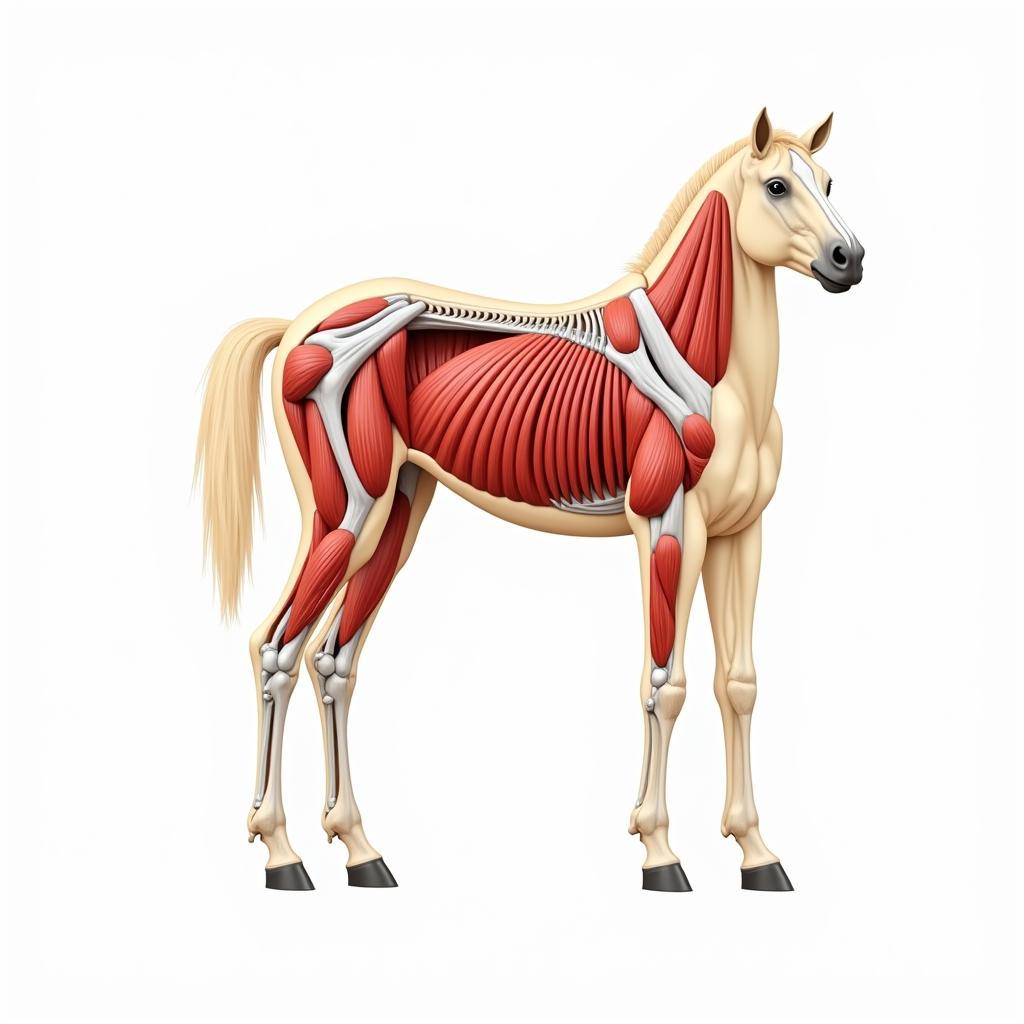The psoas muscle in horses plays a crucial role in their movement and overall well-being. It’s a deep-seated core muscle that significantly impacts a horse’s ability to perform various activities, from subtle shifts in weight to powerful strides. Understanding its function, potential problems, and care is essential for any horse owner.
The Psoas Muscle: Location and Function
The psoas muscle group is located deep within the horse’s abdomen, connecting the lumbar vertebrae to the inside of the femur (thigh bone). This strategic positioning allows it to flex the hip joint, bringing the hind leg forward. It also contributes to stabilization of the spine and pelvis, essential for balance and coordination. The psoas muscle is heavily involved in activities like collecting, jumping, and even maintaining a balanced stance. It’s a key player in the horse’s ability to generate power from the hindquarters. A healthy psoas muscle is crucial for a horse’s athletic performance and overall comfort.
 Horse Psoas Muscle Anatomy Diagram
Horse Psoas Muscle Anatomy Diagram
Common Psoas Muscle Issues in Horses
Like any muscle, the psoas can be susceptible to injury or strain. Overexertion, trauma, or poor posture can lead to inflammation and pain. Recognizing the signs of psoas muscle problems is crucial for early intervention and treatment. Symptoms can include stiffness, reluctance to move forward, difficulty picking up a canter lead, shortened stride, and back pain. Horses with psoas issues might also exhibit a “hunter’s bump,” a slight prominence over the lower back where the psoas muscle attaches to the spine. Diagnosing psoas problems often involves a thorough veterinary examination, which might include palpation, ultrasound, or other imaging techniques.
The psoas muscle in horses can be impacted by a variety of factors, including repetitive strain, sudden trauma, and even imbalances in the horse’s overall musculature.
Caring for Your Horse’s Psoas Muscle
Maintaining a healthy psoas muscle involves a multi-faceted approach. Regular exercise that encourages proper core engagement, such as hill work and core strengthening exercises, is crucial. Avoiding overexertion and ensuring proper warm-up and cool-down routines can also prevent injuries. Additionally, chiropractic care, massage therapy, and acupuncture can be beneficial for maintaining psoas health and addressing any existing issues. These therapies can help to release tension, improve flexibility, and promote healing. A well-balanced diet, providing essential nutrients for muscle health, is also a contributing factor. Remember to consult with your veterinarian or equine therapist to develop a tailored care plan for your horse. They can assess your horse’s individual needs and recommend specific exercises, stretches, and therapies.
How can I tell if my horse has a psoas muscle problem?
Look for signs like stiffness, difficulty cantering, a shortened stride, and back pain. A “hunter’s bump” might also be present.
What are some common causes of psoas muscle issues in horses?
Overexertion, trauma, poor posture, and imbalances in other muscles can contribute to psoas problems.
What can I do to help prevent psoas muscle problems in my horse?
Regular, appropriate exercise, proper warm-up and cool-down routines, and therapies like chiropractic care and massage can help maintain psoas health.
Why is the psoas muscle so important for horses?
The psoas muscle is crucial for hind limb movement, spinal stability, and generating power from the hindquarters, influencing everything from basic posture to athletic performance.
Conclusion
The psoas muscle is a vital component of a horse’s musculoskeletal system. Understanding its function, potential problems, and proper care is essential for maintaining your horse’s health, soundness, and performance. By prioritizing psoas health, you contribute significantly to your horse’s overall well-being and athletic longevity, ensuring they can enjoy a long and active life. Remember to consult with professionals for personalized guidance tailored to your horse’s individual needs.
FAQ
- What are the symptoms of a strained psoas muscle in a horse?
- How is a psoas muscle injury diagnosed in horses?
- What are the treatment options for a psoas muscle injury in a horse?
- How can I prevent psoas muscle problems in my horse?
- What exercises can help strengthen my horse’s psoas muscle?
- How long does it typically take for a psoas muscle injury to heal in a horse?
- What are the long-term implications of a psoas muscle injury in a horse?
For more information on equine health and well-being, please explore other articles on our website. If you need assistance with your horse’s psoas muscle or have any other concerns, please contact us at Phone: 0772127271, Email: [email protected] or visit us at QGM2+WX2, Vị Trung, Vị Thuỷ, Hậu Giang, Việt Nam. Our customer service team is available 24/7.